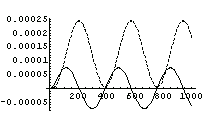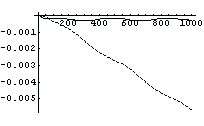|
2.2.2 System Responses, Stability, and Poles
Let us start with a quick review of the system's time-domain behaviors. First the open-loop poles of the system are computed.
These are the open-loop poles of the system.
In[4]:=
Out[4]=
This is the most unstable pole of the system.
In[5]:=
Out[5]=
The system is marginally stable. Therefore, the input disturbances would not necessarily decay and, at resonance, the output response may become unbounded. This is verified by computing the time responses.
Oscillations in the heat flow to the risers near the nominal value are used to compute the output responses of the open-loop system that is initially at rest. The oscillation frequency corresponds to one of the stable poles.
In[6]:=
Out[6]=
These are the resulting variations in the drum pressure (solid line) and in the drum liquid level (dashed line). Note that the disturbances do not decay over time.
In[7]:=

The resonance occurs when the system is excited with a signal whose frequency corresponds to the marginally stable eigenvalue, which in the system is  . Therefore, it has no imaginary part and the resonance frequency is 0 (a constant disturbance). . Therefore, it has no imaginary part and the resonance frequency is 0 (a constant disturbance).
This adds a constant 0.01 kg/s disturbance to the feedwater flow in the previous input signal.
In[8]:=
The system resonates and the drum liquid level grows without a bound.
In[9]:=

Obviously, such behavior of the open-loop system is undesirable and needs to be improved by a proper control loop.
|